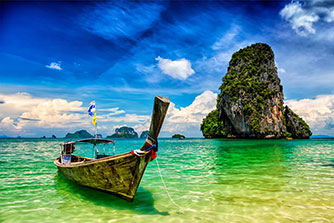
Thailand - History
 History of Thailand
History of Thailand
Thailand has been inhabited by people for the last 20,000 year, since the palaeolithic era. Inhabitation from more modern humans has been traced back to 4000 B.C.E. where evidence of rice cultivation has been discovered, into the 3rd millennia B.C.E. where bronze tools have been discovered.
Cancellation cover travel insurance.
Get an online quote for travel insurance with cancellation cover available from Travel Insurance Saver.
The Khmer people inhabited much of South-East Asia in the 9th century B.C. building parts of their empire in countries like Thailand, Cambodia, and Laos. Around the 2nd century B.C.E. the people of the region would start trading more and more with merchants from India, who brought with them Hinduism, which would influence the area. From the period 100 – 1000 A.C.E. trading increased between all areas of South-East Asia. With the crossing of borders and boundaries by merchants came the exchange of culture, ideas, and goods. Spirituality and religions from India could now be found throughout South-East Asia. In particular, the Buddhist tradition had managed to spread from India/Nepal into China, and into Thailand. There are many temples throughout Thailand built in the classical Thai archaeological style.
Already overseas travel insurance. Aussie overseas already?
Travel insurance cover is available, get a quote and compare our plans.
13th Century
Not a lot is known about Thailand prior the 13th century, much of the evidence of its history comes from archaeological finds, rather than written and recorded history. After the first millennium, Thai history and culture were better documented. Buddhism entered the country from India, and from other Indianized cultures, such as the Khmer. For example, the Dvaravati culture existed around 700 A.C.E. and was heavily influenced by Buddhism and Indian culture. The Indian traders affected much of Southeast Asia, and with Indian traders came Trade from West-Asia and Europe. Coins from Rome dated from 230 A.C.E. have been found at U Thong, one of the primary Dvaravati cities. Thailand is a wonderful country to visit for its rich culture.
Compare our travel insurance from Travel Insurance Saver for your next holiday away.
The Thai people are said to have originated from Guangxi in China. Guangxi today is on the border with Vietnam, close to Thailand. It was during the second millennium, in the 1200s, that the Thai city-states started to separate themselves from a dwindling Khmer power. It was out of this weakened regime that the Sukhothai Kingdom emerged, who had a special way of ruling. Their method of rule was the ‘father governs children’ way, where the people would come to the king and voice their problems, they even had a special bell at the palace which people could ring to seek counsel.
17th Century
Leading up to the 17th century, Thai history is dominated by what’s known as the Ayutthaya period. The Ayutthaya people lived on an easily defensible island, and so their power flourished throughout Thailand. The word Ayutthaya is derived from the Indian language.
Travel Insurance for Travellers of All Ages.
Get A Quote!
Ayutthaya was also known as Siam which is the more common name. Ayutthaya was generous towards traders from all around the world, including Europe, and allowed them to establish camps at the city’s boundary. This amiability with global merchants transformed Thailand into a hotspot for foreign traders and particularly attracted the attention of the Portuguese. The period of trade with the Portuguese led to unprecedented economic growth, and Ayutthaya was known as the largest city in the world during the 1700s.
Contact Travel Insurance Saver for overseas travel insurance quotes today.
19th Century
The 1900s were characterized by the end of absolute monarchic rule in Thailand, and the signing of the Permanent Constitution of Siam ensured a change of rule in Thailand. A prime minister was instated, and Thailand became a constitutional monarchy. During the 1930s and ’40s, fascists tried to change the regime in Thailand. Enemy number one was ethnic diversity in Thailand, and the movement was characterized by pan-nationalism i.e., only buying Thai products, respect for the national anthem etc. Thailand would attack the French presence within South-East Asia in what would become the Franco-Prussian war. Soon Japan would invade Thailand, and they’d sign a peace treaty, with Thailand and Japan eventually forging a military alliance. After WW2 the allies would occupy Thailand, with the Gurkhas imprisoning many of the Japanese occupants of Bangkok.
Back to Thailand Travel Insurance page.
Before choosing a policy, please be aware that terms and conditions, exclusions, limits and/or sub-limits will apply to most sections. It is important to read the Product Disclosure Statement (PDS) before making any purchase to ensure the cover provided matches your specific requirements.







